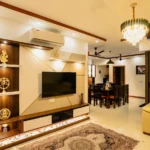Introduction
The concept of the Nadumuttam—an open courtyard at the centre of traditional Kerala homes—has quietly made its way into modern architectural conversations. As cities expand and homes become more compact, homeowners like you are increasingly looking for ways to blend culture, comfort, and functionality in your space. Introducing a central courtyard not only provides your home with a breathing core but also creates a unique space for family interaction, natural light, and airflow. For today’s urban home, a Nadumuttam-inspired courtyard offers a blend of tradition and modernity that you can truly enjoy.
How to Bring the Nadumuttam Concept into Contemporary Homes

One of the most striking aspects of the Nadumuttam is the ability to adapt this space to a variety of home sizes and designs. You don’t need a grand villa to introduce a central courtyard. Even in smaller urban homes, a thoughtfully designed courtyard can become the heart of your living space.
Here are some ways to effectively implement the Nadumuttam in your home:
- Central Openings: If space allows, create a central opening in your home that leads to the courtyard. This space can be left open to the sky or partially covered with a retractable roof to shield it from the weather.
- Vertical Gardening: Use vertical gardening to make the most of limited space. By growing plants vertically, you add greenery without taking up valuable floor space.
- Use of Glass Panels: Glass can help maintain an open feel while protecting from the elements. A glass-panelled roof or walls can create an enclosed yet open atmosphere.
The central courtyard’s design can serve both functional and aesthetic purposes. It naturally divides spaces while maintaining an open, airy atmosphere. It can be a place for relaxation, entertainment, or reflection. In fact, as homes become more compartmentalised, a Nadumuttam-style courtyard acts as a reminder of the value of open, communal spaces.
Creating a Harmonious Space with Nature
Incorporating nature into your home is another hallmark of the Nadumuttam—its ability to connect the indoors with the outdoors. This central space can be an oasis of plants, sunlight, and fresh air.
Consider the following elements when designing a nature-inspired courtyard:
- Plant Selection: Use plants that thrive indoors and outdoors, such as ferns, ivy, or bamboo. These plants offer a rich green landscape while purifying the air.
- Natural Materials: The Nadumuttam often made use of local, natural materials like wood, terracotta, and stone. You can recreate this by using these materials in your flooring, furniture, or walls. These elements make the space feel more authentic and grounded.
- Water Features: Adding a small water feature like a fountain or a reflecting pond can enhance the courtyard’s calm, serene atmosphere. Water features also have the added benefit of soothing sounds, which can mask urban noise.
In terms of maintenance, select plants that are easy to care for. Consider low-maintenance options like the snake plant or spider plant, which thrive in both indoor and outdoor conditions. With these, your courtyard will remain lush and green year-round without requiring constant upkeep.
Functionality Meets Aesthetic Appeal
While aesthetic appeal is key, functionality is just as important when designing a courtyard. The space can serve multiple purposes, from being a space for outdoor meals to a quiet area for reading or meditation.
Here are some functional ways to use the courtyard:
- Flexible Seating: Consider modular seating that can be rearranged based on your needs. Outdoor cushions, pouffes, and bean bags can be arranged for casual conversations, or you can use folding chairs and tables for a more structured setting when hosting guests.
- Lighting and Ambience: As the day winds down, the lighting you choose for your courtyard can set the mood. String lights or lanterns can create a magical, relaxed atmosphere for evening gatherings.
- Outdoor Dining: With enough space, your courtyard can become an ideal spot for outdoor dining. Whether it’s a small breakfast table or a larger dining area for family gatherings, this open-air area adds another layer to your home’s functionality.
As urban living spaces grow smaller, having a central courtyard to serve as a versatile zone offers both practical use and aesthetic pleasure. It becomes a focal point of relaxation, bringing calm and an inviting atmosphere to your everyday life.
The Role of Natural Light and Ventilation
One of the most powerful aspects of a Nadumuttam-inspired courtyard is its ability to bring natural light and ventilation into the heart of your home. Homes that are naturally lit and ventilated are not only healthier but also feel more vibrant and inviting.
Incorporating a courtyard into your design allows light to penetrate into even the darkest corners of the house. Consider these strategies to maximise light and airflow:
- Skylights: Install skylights in the roof of the courtyard to allow natural light to flow in from above.
- Cross-Ventilation: Position the courtyard in such a way that it opens up to other areas of the home. This allows fresh air to circulate freely, reducing your reliance on air conditioning.
- Reflective Surfaces: Light can be amplified with the use of mirrors or reflective surfaces, helping the light bounce through the house.
On days when the weather is favourable, you can leave the roof open, allowing your home to enjoy the full benefits of the sun’s warmth. In colder months, consider covering the courtyard partially with glass panels or clear plastic to trap warmth inside.
Designing for Privacy and Openness
Maintaining privacy while still creating an open, inviting space can be a challenge. A traditional Nadumuttam was often framed by walls or rooms, creating a balance between openness and privacy. This can be adapted in modern homes to achieve the same effect.
Here’s how to combine privacy with openness:
- Use of Walls: You can incorporate walls around the courtyard that are partial or designed with open slats. This gives the space an enclosed feeling while still allowing light and air to filter through.
- Partition Screens: Bamboo or wooden partition screens can help divide the courtyard from other parts of the home without making it feel closed off. This allows the space to remain private, yet connected to the rest of the house.
- Strategic Plant Placement: Tall plants, like palm trees or bamboo, can be used to provide a natural barrier. This allows for privacy without losing the feeling of being outdoors.
Balancing openness and privacy ensures that your courtyard can be both a personal retreat and a social space, depending on how you use it.
Modern Materials with Traditional Roots
A key feature of Nadumuttam courtyards is the use of local and traditional materials, such as terracotta tiles, wood, and laterite stone. These materials gave the space a timeless and natural feel. Modern interpretations of this design often combine these traditional elements with contemporary materials.
- Modern Concrete and Stone: You can use concrete, marble, or granite to create a clean, modern surface while still incorporating traditional elements like wood accents or terracotta planters.
- Reclaimed Wood: Incorporating reclaimed wood for furniture, shelves, or beams adds both character and sustainability to the design.
- Textured Walls: Textured walls made of natural materials like limestone or clay add visual interest while remaining in line with the earthy theme of a Nadumuttam.
These modern materials are not only visually pleasing but also durable, providing long-lasting functionality without compromising on aesthetic appeal.
Final Thoughts on Incorporating Nadumuttam into Your Home
Incorporating a Nadumuttam-inspired courtyard into your urban home is about creating a space that balances heritage with modern needs. It is an investment in your home’s aesthetic, functionality, and the overall quality of life for you and your family. This central space becomes more than just an architectural feature—it enhances your daily routines and connects you to the natural world, all while maintaining privacy and comfort.
By thoughtfully designing your Nadumuttam courtyard with an eye for detail, you ensure that it becomes an integral part of your home. From enhancing light and airflow to creating a peaceful retreat, this modern courtyard brings both beauty and functionality to urban living.
Conclusion
Integrating a Nadumuttam-inspired courtyard into your urban home not only honours tradition but also creates a space that enhances your daily life. With the right design elements, you can make your home a haven of peace, light, and connection with nature. It’s not just about architectural beauty—it’s about creating a lifestyle that reflects both your cultural heritage and modern needs. And if you need help bringing this vision to life, professional designers can guide you every step of the way.







